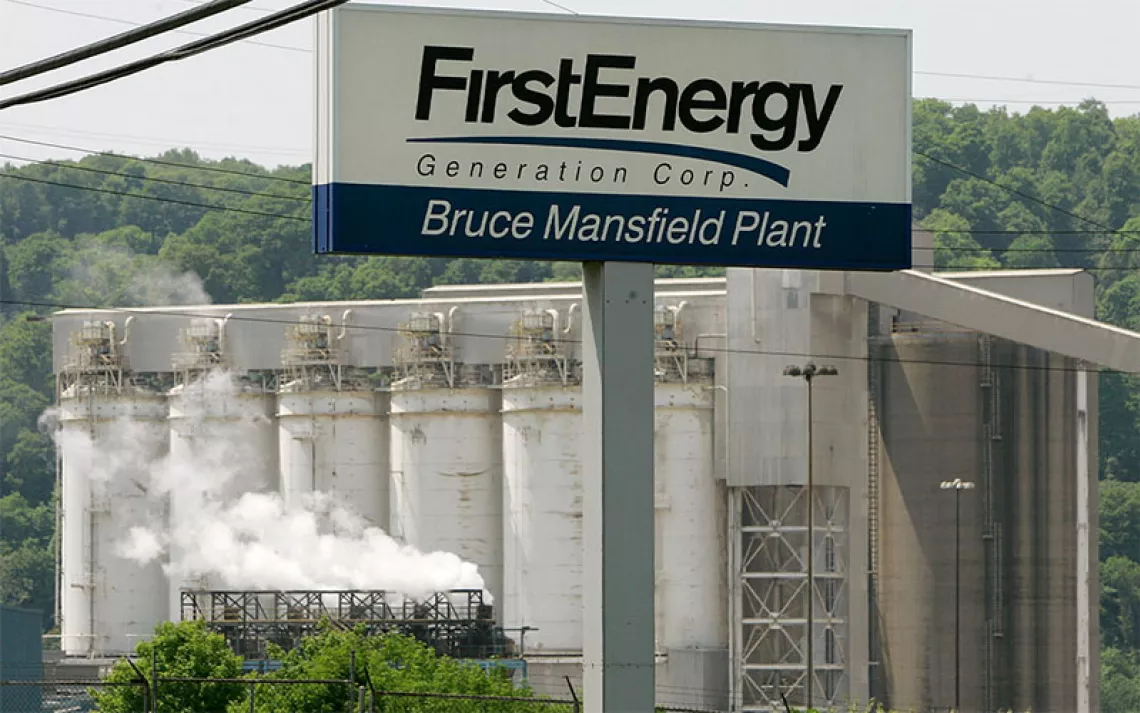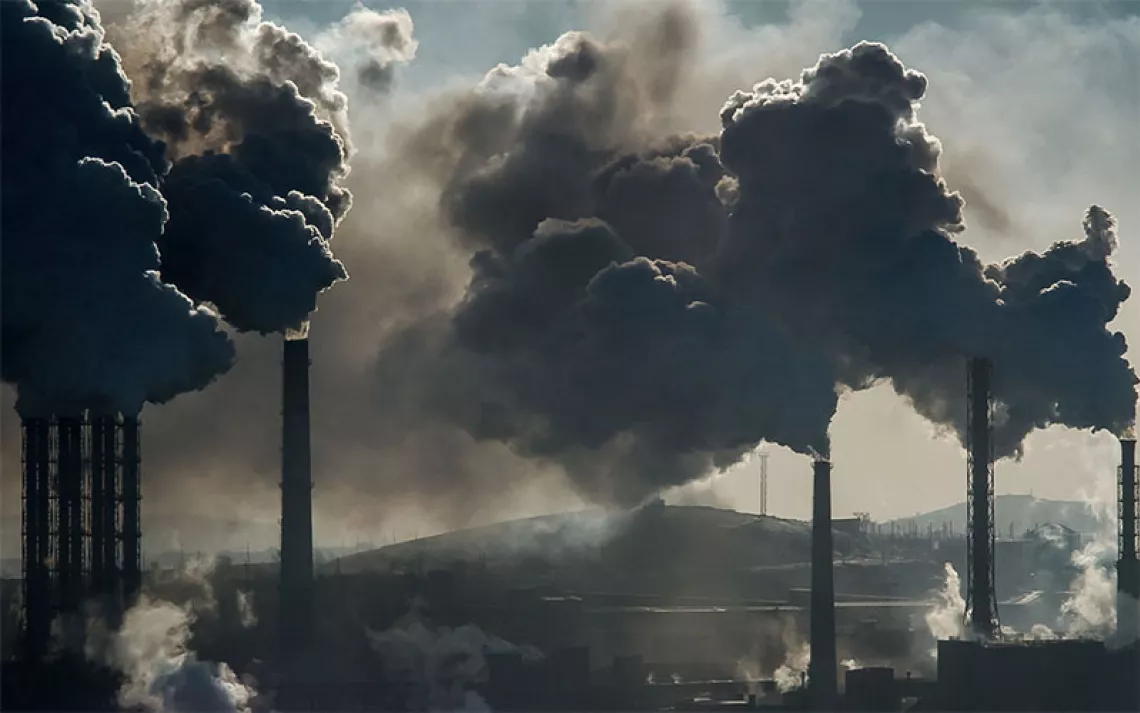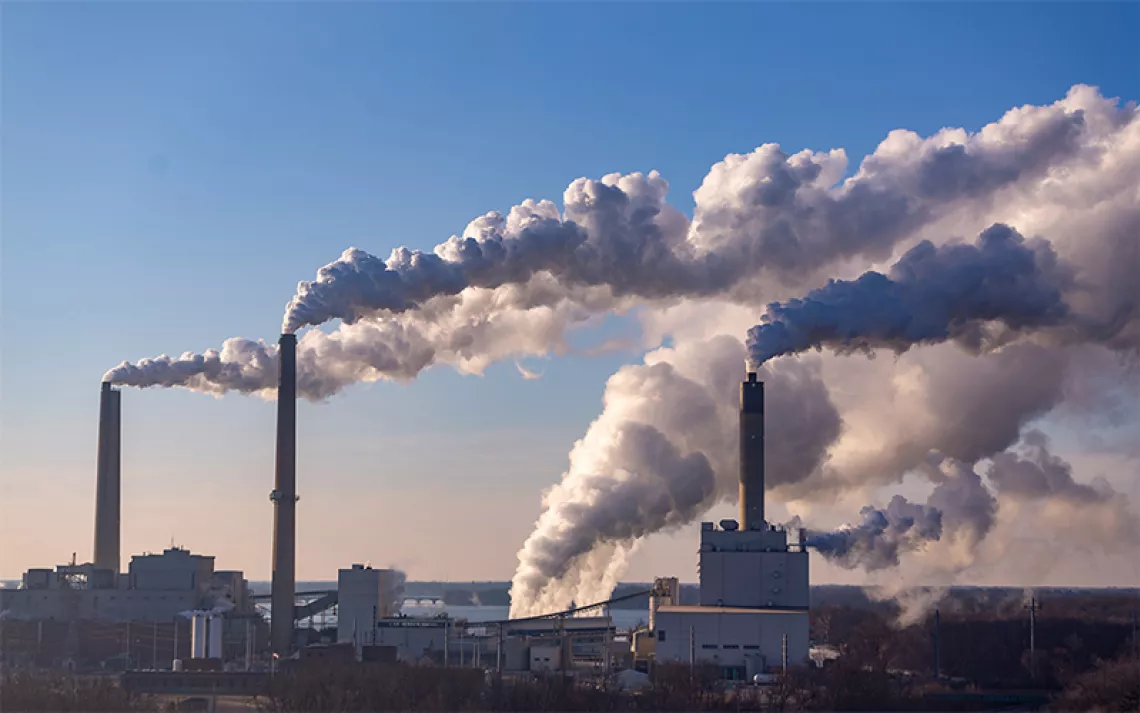Carbon States of America
We can export vast amounts of coal, oil, and natural gas, or we can protect future generations from climate change. We can't do both.

Illustration by David Plunkert
LIKE AN ABSTEMIOUS DRUG DEALER or a pious inside trader, the United States is a carbon hypocrite. While we congratulate ourselves for having decreased our energy-related greenhouse gas emissions by 12 percent since 2005, the year U.S. oil consumption peaked, we're simultaneously turning into what some boosters call "Saudi America"—a major world source of coal, oil, and natural gas. Collectively, these were our number-one export last year. We're cutting back on the crack, but selling it to the kids next door.
According to BP, the United States led the world in oil growth in 2012; we now produce more than 7 million barrels a day, the highest level in 20 years. By 2017, predicts the International Energy Association, we could surpass Saudi Arabia as the world's largest producer of oil. We already lead the globe in recoverable reserves of coal. And the introduction of hydraulic fracturing, or fracking, while fraught with environmental peril, has unlocked not only oil trapped in shale formations but also huge reserves of gas, making us the world's top natural gas producer.
Shipping millions of tons of coal and billions of cubic feet of natural gas to Europe, South America, and Asia is a huge industrial enterprise, requiring a vast new infrastructure of pipelines, storage facilities, and export terminals. (U.S. law currently forbids the export of domestically produced crude oil, a ban the industry is lobbying to overturn.) Building that infrastructure requires federal environmental approval, which could depend on whether the United States is willing to take responsibility for the enormous climate-changing potential of exporting its carbon reserves.
IN TERMS OF RAW TONNAGE, the biggest carbon export scheme is to ship the coal reserves of the Powder River Basin in Montana and Wyoming to the blast furnaces and power plants of Asia, particularly China. Here at home, coal is declining as a source for electric power. Because of plummeting natural gas prices, energy efficiency regulations, and the efforts of the Sierra Club's Beyond Coal campaign, 150 U.S. coal plants—nearly a third of the nation's total—have retired or are scheduled to do so. But China's grassroots environmental lobby is in its infancy, and coal consumption there has risen in each of the past dozen years. China now burns nearly as much coal as is burned by the rest of the world combined.
The Powder River Basin is well placed to feed China's carbon hunger. Its strip mines produce hundreds of millions of tons of coal a year, which the federal Bureau of Land Management sells to coal companies at below-market prices. (A June 2012 report by the Institute for Energy Economics and Financial Analysis inspector general found that the agency's largesse has cost taxpayers $28 billion over the past 30 years.) Annual exports from the basin, however, are only 15 million tons, limited largely by the paucity of West Coast shipping terminals.
The coal industry hoped to increase its export capacity by building six new terminals in Oregon and Washington. Fierce opposition from Beyond Coal and other environmental groups, together with the dicey economics of the situation, meant a quick end to three. Left standing are proposed facilities at the Port of Morrow in Oregon and Cherry Point and Longview in Washington.
The Sierra Club, governors John Kitzhaber of Oregon and Jay Inslee of Washington, plus several members of Congress urged the U.S. Army Corps of Engineers to do a broad environmental review of the remaining projects—including the climate effects when all that coal is burned in China.
"If the United States is going to embark on the large-scale export of coal to Asia," Kitzhaber wrote in April 2012 to then-interior secretary Ken Salazar, "it is imperative that we ask—and answer—the question of how such actions fit with the larger strategy of moving to a lower carbon future."
"This is the largest decision we will be making as a state from a carbon pollution standpoint," Inslee said. "Nothing comes even close to it."
Area residents backed up their governors. A public hearing in Seattle drew upwards of 3,000 people, overwhelmingly opposed to the coal yards. Close to 2,000 filled a high school in Bellingham, Washington, with hundreds more waiting outside in a driving rain for a chance to speak. Staff of the Oregon Department of Environmental Quality said the public response to the Port of Morrow project was the largest in the agency's history. Even in rural Clatskanie (population 1,737), 200 people turned up at a hearing, with only 5 speaking in favor of the coal terminal.
The Army Corps of Engineers was unmoved. Appearing before a congressional committee, Jennifer Moyer, the Army Corps' acting regulatory chief, declared there to be "no compelling justification" to take a broader look at the projects' carbon impact: "The effects of the burning of the coal in Asia or wherever it may be is [sic] too far removed from our action to be considered as an indirect effect or a cumulative effect of our action itself."
Happily, the co-lead agency on the Washington projects, the state Department of Ecology, does not share the Army Corps' "out of sight, out of mind" approach. In July, it announced that it will conduct a "deep review" of the Longview terminal's effects on both human health (from diesel emissions and coal dust) and climate change, including—in what is a first for an environmental review of an export terminal—the burning of the coal abroad.
UPENDING DECADES OF WORRIES about dependency on imported oil, North America's oil sector is now booming. At the end of May, the United States produced more crude oil than it imported for the first time in 16 years, with production spiking to 7.3 million barrels a day from 5 million barrels a day in 2008. Simultaneously, it has gone from being a net importer of refined petroleum products to an enormous exporter.
While the federal law instituted in the wake of the 1973-74 Arab oil embargo still largely prohibits exports of crude oil that's extracted from American soil, it does not apply to diluted bitumen and other sludgy proto-petro products from Canada. The Keystone XL pipeline—at the time of this writing still under active consideration—could transport more than a million barrels a day from Alberta, Canada, to refineries in Texas. That influx would create a massive oversupply of heavy oil on the Gulf Coast, leading to the export of the dirty fuel into the world market. Without Keystone, said a June 2013 report from Goldman Sachs, "we believe risk would grow that Canadian heavy oil/oil sands would remained trapped in the province of Alberta."
The U.S. State Department, in its draft environmental review of the Keystone project, clung to the notion that the oil would get out somehow. "Approval or denial of the proposed project is unlikely to have a substantial impact on the rate of development in the oil sands," it concluded, "or on the amount of heavy crude oil refined in the Gulf Coast area." By this analysis, if the tar sands oil would find its way to market by some other route, there would be no net increase in carbon emissions by sending it through Texas. Indeed, many other pipelines on the drawing board would remain within Canadian territory and thus not trigger U.S. environmental review. The Northern Gateway pipeline would run west to Kitimat, in British Columbia, carrying 525,000 barrels a day, while Energy East would carry 1.1 million barrels a day all the way to New Brunswick. However, both face daunting obstacles, chief among them the opposition of Canada's First Nations, across whose sovereign lands they would have to travel.
Canada insists that if the pipelines are not built, the same amount of crude could be shipped by train. "At the end of the day," Canadian ambassador to the United States Gary Doer told the Globe and Mail, "it's trains or pipelines." At present, though, only 2 percent of Canada's oil exports move by train. And the likelihood of rail replacing pipelines greatly decreased after an oil train derailed and exploded in July in Lac-Megantic, Quebec, killing 47 people.
FRACKING HAS SO TRANSFORMED the natural gas picture in the United States over the past decade that facilities originally constructed to import liquefied natural gas from abroad are now being rejiggered for export. If all of the 28-some proposed liquefied natural gas export facilities were completed, they could send abroad up to 45 percent of U.S. natural gas production.
While President Barack Obama has raised questions about the climate effects of tar sands oil from Keystone, his administration appears to be gung ho on the subject of exporting natural gas. In reiterating his support for Obama's "all of the above" energy policy to the Associated Press in June, for example, Department of Energy Secretary Ernest Moniz vowed quick decisions on the numerous export proposals. "We expect to have significant action this year on a case-by-case basis," he said.
The Energy Department recently approved three export terminals, two in Louisiana and one in Texas. The department's discretion is limited to countries with which the United States doesn't have free trade agreements. Approval for export to countries with which we do have such agreements—for the moment, primarily Canada and Mexico—is mandatory. (That, after all, is the essence of free trade.)
Environmentalists' unlikely ally in trying to slow natural gas exports is the chemical manufacturing industry. Just over half of natural gas goes to heating furnaces and stoves and producing electricity; 28 percent of it is used by industry to manufacture plastics, petrochemicals, and fertilizers. The sudden U.S. glut makes gas cheaper at home than overseas, giving our industry a competitive advantage. "If we allow the world gas price to come to this country by exporting gas," Dow Chemical CEO Andrew Liveris complained, "then it will destroy the benefits of plentiful cheap gas."
That bounty, however, is primarily obtained via fracking, a process that the Energy Department's own advisory board has warned comes with "serious environmental consequences." These include the leakage of large amounts of methane, an incredibly potent greenhouse gas; the contamination of groundwater; and, when drilling fluids are reinjected into the earth, even the promotion of earthquakes. Air pollution is another concern: Parts of gas-rich Wyoming now have worse smog than Los Angeles.
Exporting natural gas would mean much more of the above. According to an Environmental Information Administration report commissioned by the Energy Department, two-thirds of export demand would be met by increased domestic production, almost entirely via fracking in thousands of new wells over the next several decades. And finally, the upward price pressure brought about by exports could even make coal competitive once again, just when it seemed to be on its last legs.
The Sierra Club is calling for a full environmental impact assessment of the implications of natural gas exports. And it's not just the Club: The EPA has repeatedly said the same. But like the Army Corps' head-in-the-sand attitude to downstream carbon burning, both the Energy Department and Federal Energy Regulatory Commission have refused to consider the climate consequences of exporting natural gas.
IN HIS JUNE 25 ADDRESS on climate change at Georgetown University, President Obama seemed to lay out a new standard to assess fossil fuel projects: "Our national interest will be served only if this project does not significantly exacerbate the problem of carbon pollution," Obama said.
That "national interest" is exactly what the Energy Department is supposed to consider when it rules on natural gas exports. Yet it refuses to address the climate effects. It could be otherwise: In Obama's first term, his Council on Environmental Quality drew up a wide-ranging rule that would have directed all federal agencies to consider climate impacts before approving major projects. Three years later, the rule remains in limbo.
In his State of the Union speech this February, Obama made a strong call for climate action, urging Congress to pass "a bipartisan, market-based solution." Acknowledging the extreme unlikelihood of that happening, he promised not to let it stand in the way of needed action. "If Congress won't act soon to protect future generations," he said, "I will." He could start by requiring his federal agencies to exercise climate responsibility.
 The Magazine of The Sierra Club
The Magazine of The Sierra Club



